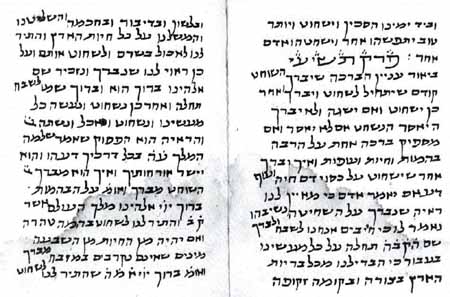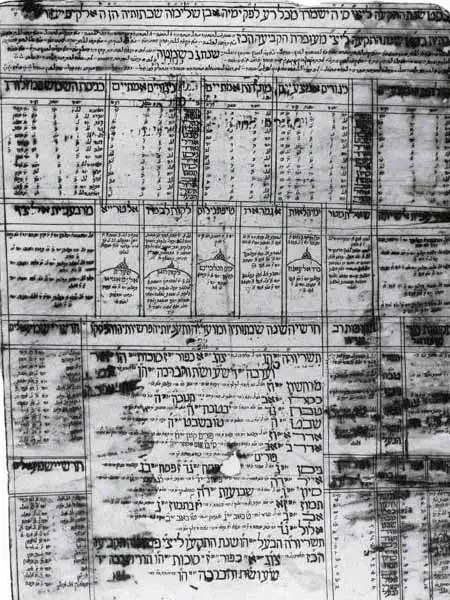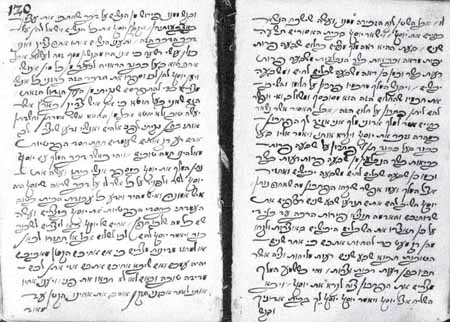Witnesses to History: The Written Word
Three manuscripts in the Hebraic Section permit us to witness the extent of Karaite sectarianism in the fourteenth century; a visit to an Egyptian synagogue in the nineteenth; and a glimpse at Jewish life in the Islamic Middle East in the eighteenth.
The oldest dated Hebrew manuscript at the Library is a thirteen-page Hilhot Shehita (Laws of Ritual Slaughtering) by the Karaite scholar Israel Ma'arabi, written in 1397 by the scribe Joseph ben Abraham ben Joseph. The Karaite sect, as noted, had its origins at the beginning of the eighth century and rejected Talmudic-rabbinic tradition, so it is not surprising to find in this manuscript that a Karaite shohet (ritual slaughterer) is required to deny the Rabbanites' "Mishnah and Talmud."
 |
A manuscript wall calendar for the year 5575 (1815), which apparently hung in an Egyptian synagogue, is of interest to students of the Jewish calendar, the synagogue, and Egyptian Jewry Twenty-four by eighteen inches in size, it contains the reckonings of Mar Samuel and Rav Adda. The former, head of the Nehardea Academy in Babylon in the second century, reckoned the year to consist of fifty-two weeks and one and one-quarter days. Over the course of twenty-eight years he made the adjustments necessary to bring the solar and lunar calendars into harmony. A more exact calculation of the length of the year is attributed to a Rav Adda (probably, Rav Addah ben Ahavah), a third-century Babylonian scholar. Both ancient calculations persist in this nineteenth-century Jewish calendar, which also notes the "Islamic months."
 |
The most interesting manuscript is a Hebrew translation of the Koran, one of only three such extant Hebrew manuscripts, the others being in the Bodleian Library at Oxford, and the British Library in London. The Library of Congress Hebrew Koran is a manuscript of 259 leaves, without a title page, and it contains no indication as to translator, scribe, or place and date of composition.
 |
In a tour de force of bibliographical sleuthing, Myron M. Weinstein, former Head of the Hebraic Section, using both painstaking scholarship and creative imagination, offers the missing date and even a nineteenth-century provenance. In his "A Hebrew Qur'an Manuscript" in Jews in India, edited by Thomas A. Timberg, Weinstein, in elegant narrative style, leads the reader along a thoroughly documented road, at whose end we are convinced that this Hebrew version is a translation from a Dutch copy which is itself a translation from the French translation of the original Arabic. Weinstein also persuades us that the translator is Leopold Immanuel Jacob van Dort, a Jewish convert to Christianity who was professor of theology in Colombo, Ceylon, and that the scribe was David Cohen, a native of Berlin then residing in Cochin, a city on the southwest coast of India. Weinstein is equally persuasive about the manuscript being written in Cochin in the 1750s or 1760s, probably in 1757, when van Dort was visiting that city, and that is the volume the missionary Joseph Wolff saw in Meshed, Persia, in 183 1, when he encountered a group of Jewish Sufis. Wolff writes:
I met here in the house of Mullah Meshiakh with an Hebrew translation of the Koran, with the following title: "The Law of the Ishmaelites, called the Koran, translated from the Arabic into French by Durier, and from the French into Dutch by Glosenmachor, and 1, Immanuel Jacob Medart, have now translated it into the holy language, written here at Kogen, by David, the son of Isaac Cohen of Berlin."
From Cochin to Meshed to Washington, and who knows where in-between, a hegira from the ends of the earth indeed!
Sources: Abraham J. Karp, From the Ends of the Earth: Judaic Treasures of the Library of Congress, (DC: Library of Congress, 1991).


